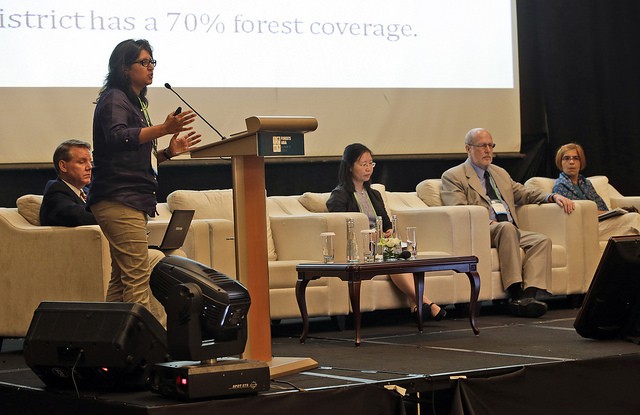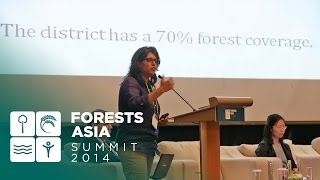
A persistent divide in policy governing agriculture and forest management must be bridged, according to experts at a recent conference who called to “change the relationship” between the two sectors.
A panel discussion at the recent Forests Asia Summit in Jakarta provided examples of successes and failures in policy integration across Asia, where governments face the competing challenges of economic growth, food security for a growing population and protection of the region’s rapidly vanishing forests.
“There has been a separation of farms and forests in policy, while these landscapes are actually merged together,” said panelist Kanchi Kohli, an independent researcher from India.
This sectoral divide can be detrimental to biodiversity, food security and the ability of landscapes to provide ecosystem services, panelists concurred, exploring examples of public policy effects on both sectors.
Xie Chen of the Forest Economics and Development Research Center of China’s State Forestry Administration discussed some of the successes of integrating agricultural and forestry perspectives in policy under China’s Conversion of Cropland to Forest Program (CCFP; also known as ‘Grain for Green’ or the ‘Sloping Land Conversion Program’). Through CCFP, the government subsidizes 32 million rural households to plant trees in place of cropland.
Launched in 1999 in response to significant flooding and erosion due to highly degraded land, the project initially focused only on afforestation, but recent changes show significant impacts on food security and other ecosystem services.
“Gradually, we recognized the farmers’ livelihoods … at the very beginning we had forbidden the intercropping in CCFP land, but after that we encouraged intercropping, and also we allowed economic tree plantations,” Chen explained.
The payoff has been significant. By allowing rural households to view their agricultural and forested land in a holistic way, the program has increased production of many forest foods, including fruits, edible oils, medicinal plants and more.
For example, household fruit consumption increased: “The land conversion policy fruits contribute 30 percent of fruit supply,” Chen said. The productivity of agricultural land has also increased, with grain output per hectare rising among participating households. The increase in forested land also showed a reduction in vulnerability to natural disasters. These outcomes are thanks to what Chen called “trying to balance our agriculture and forest policy.”
POLICY ROADBLOCK
Kohli provided an alternative scenario from her native India, where “the separation of farms and forests began in colonial times” and continues. In parts of India’s Karnataka state, forests and farms exist in an interconnected mosaic landscape; farmers traditionally use forests for collecting important foods as well as leaf litter. Forests are integral to the food security and food production of the area, but new government policy aimed at protecting forests has resulted in communities losing the right to use those forest products, she said.
“Forests were separated from food, while as we know forests also provide food,” Kohli said. “What is really affected by these hard boundaries is the freedom to choose what is food and how it should be produced.”
In India, agroforestry programs exist under both the Indian Ministry of Agriculture and the Ministry of Forestry — but these programs don’t talk to each other, she said. She argued that politicians and researchers need to focus on repairing what she called “the fracture between forests and farms.”
Dietrich Schmidt-Vogt, a senior scientist with the World Agroforestry Centre (ICRAF) in China, provided examples from around the Mekong Basin of how land-use change affects forests and agriculture. As Schmidt-Vogt explained, prior to these land use changes, up until the 1950s and ’60s, “the dominant type of land use in this area was shifting cultivation … which maintains a forest landscape in a kind of dynamic equilibrium.”
He pointed out that landscapes with shifting cultivation can be quite diverse: After a period of cultivation, the forest grows back over a fallow period of 10 years or more, thus the landscape includes crop lands and forest at various stages of regrowth, providing high levels of biodiversity and food security.
Schmidt-Vogt’s examples from three countries shows three very different changes in land use according to political and economic context: field crops mixed with forests now dominate in Thailand; maize crops have been adopted in Vietnam; and rubber plantation forestry has taken hold in China, where policies promote tree planting.
‘CHANGE THE RELATIONSHIP’
Food security has declined in the Chinese context, with nearly exclusive rubber plantation forestry replacing shifting cultivation, Schmidt-Vogt explained. The monocrop has also created increased vulnerability to changes in the price of rubber. In the Chinese case, Schmidt-Vogt showed that increased tree cover comes at the expense of natural forest. Biodiversity is being lost, further jeopardizing food security as secondary forests are taken over by monocrop rubber plantations.
Overall, the panelists called for an integrated, landscapes approach to agricultural and forest policy to account for the interconnectedness of both types of land use.
“There is an assumption that food production and biodiversity conservation are linked in an inverse relationship, and these presentations challenge that assumption,” argued Kiran Asher, Senior Scientist at the Center for International Forestry Research (CIFOR), who led the discussion session. Instead, she said, the unintended consequences of some attempts at green growth — such as rubber plantations in the Mekong region — are in fact detrimental to both biodiversity and food security. As a result, she said, “we have to change the relationship between food and forests.”
We want you to share Forests News content, which is licensed under Creative Commons Attribution-NonCommercial-ShareAlike 4.0 International (CC BY-NC-SA 4.0). This means you are free to redistribute our material for non-commercial purposes. All we ask is that you give Forests News appropriate credit and link to the original Forests News content, indicate if changes were made, and distribute your contributions under the same Creative Commons license. You must notify Forests News if you repost, reprint or reuse our materials by contacting forestsnews@cifor-icraf.org.

